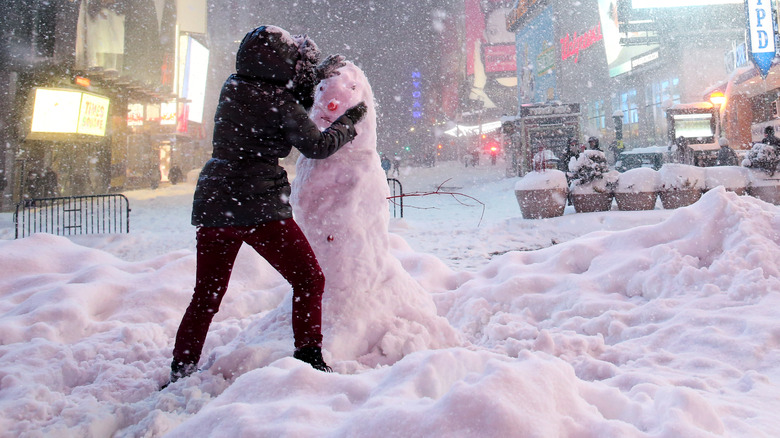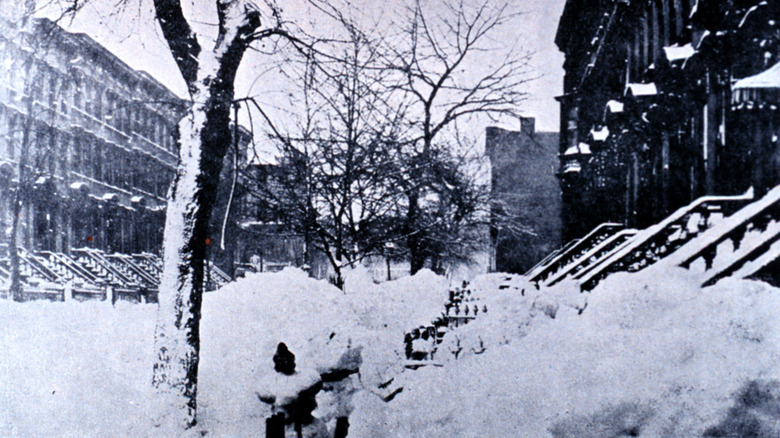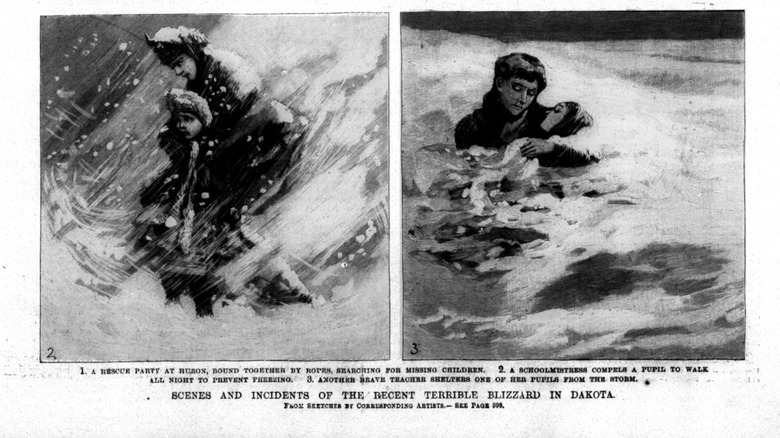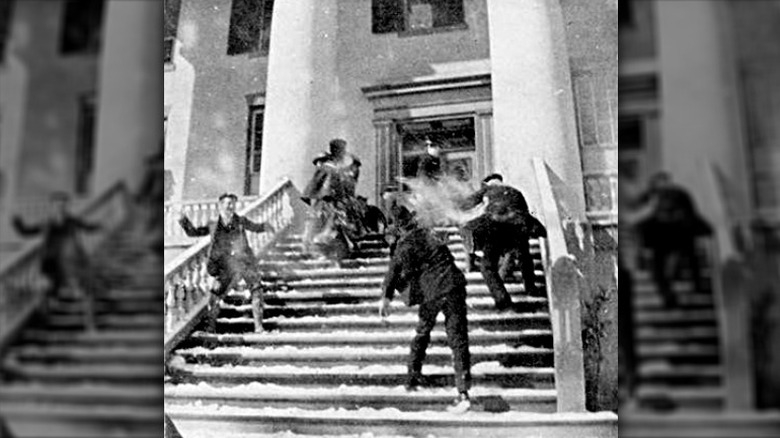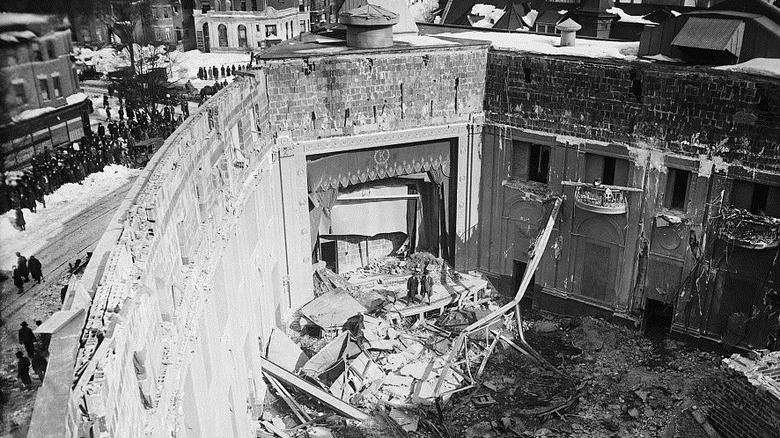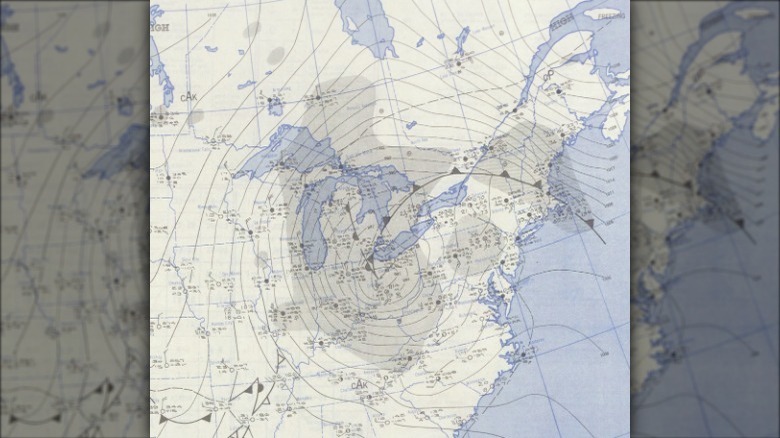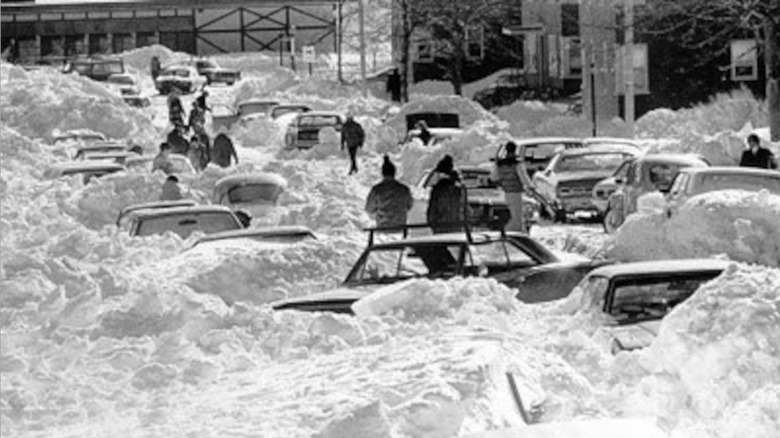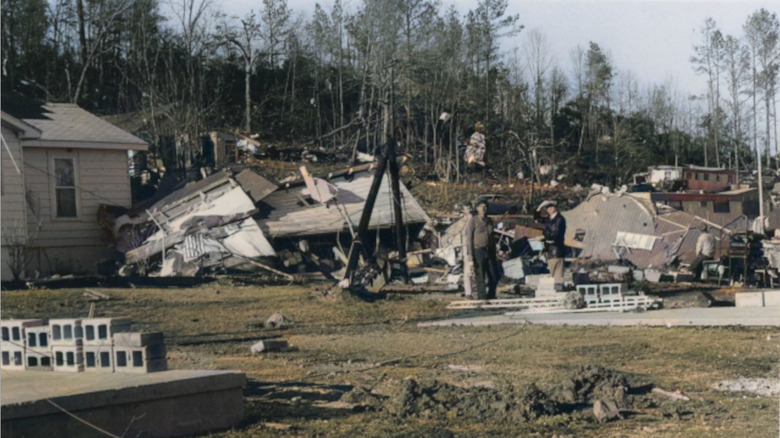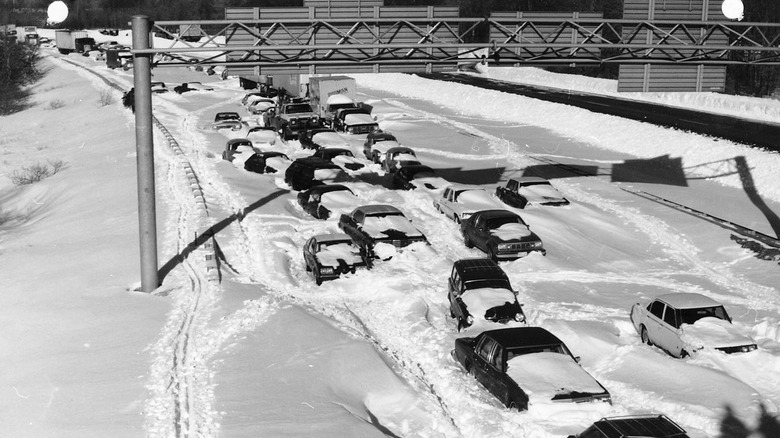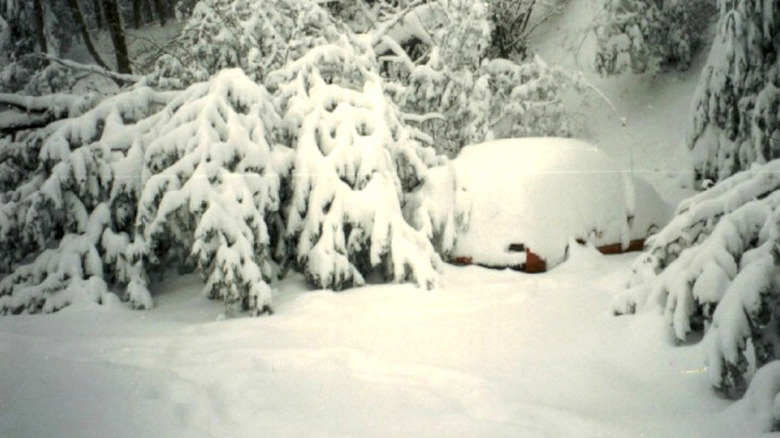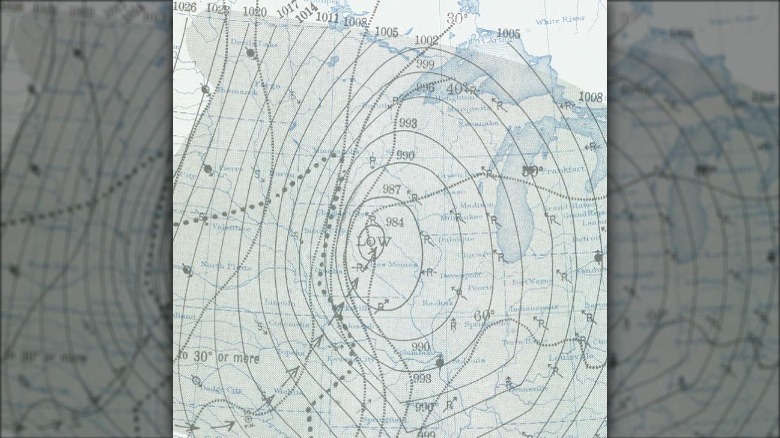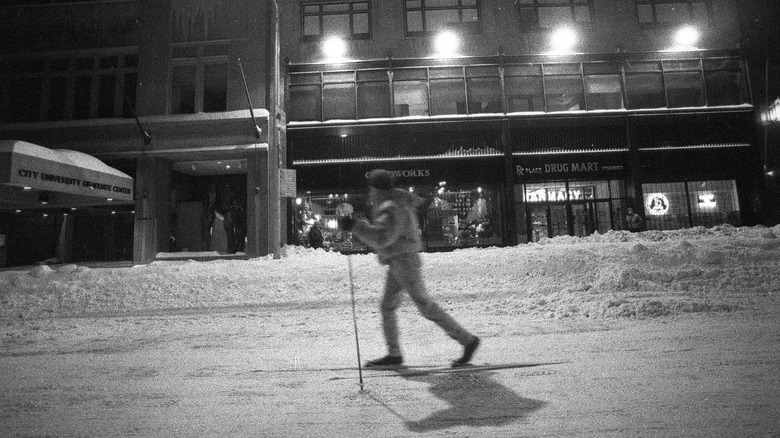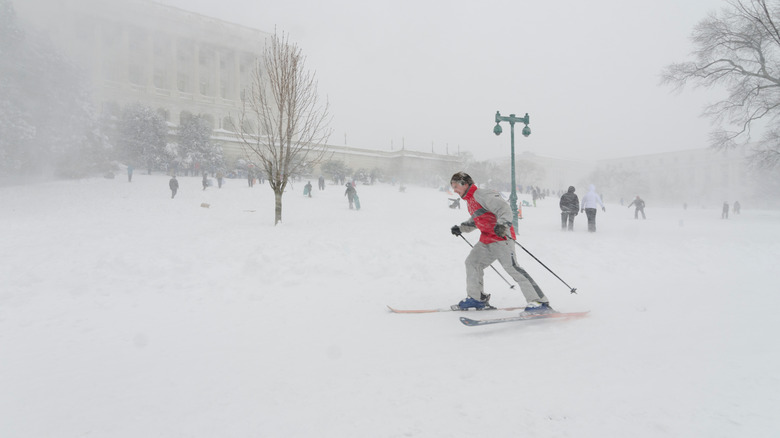The Worst Winter Storms In US History
For most of the United States, winter means at least the slight risk of snow — and if you think your area is immune because it's in the southern U.S., contemplate the fact that in 1977, it actually snowed in South Florida, according to CBS News.
That snowstorm only lasted a little over an hour and the snow melted away almost immediately, so no one in Miami should be investing in snow boots and shovels any time soon. Other parts of the country, however, are at greater risk of having daily life interrupted by heavy snow. And while any major snow storm has the potential to disrupt your life, damage your property, and make you hate winter, sometimes Mother Nature conspires to whip up a storm powerful enough to make some dark, unfortunate history.
That's because winter storms carry some unique threats. Heavy snow reduces visibility and traction on roads, causing accidents. Wet snow is difficult to shovel and can cause heart attacks even in relatively healthy people, according to Harvard Health. And several feet of snow can shut down entire areas of the country, making it nearly impossible to deliver supplies or get emergency vehicles out in response to disasters. In other words, winter storms are dangerous. Here are the worst winter storms in U.S. history.
The Great Blizzard of 1888: 58 inches, 400 deaths
According to The Washington Post, in early March 1888 the weather conspired to produce what remains the most severe blizzard ever experienced by the northeastern U.S. Low pressure, high winds, and heavy snow saw the temperature drop to 6 degrees in New York City. The storm moved slowly and even paused for a while in a holding pattern, merrily dumping snow for nearly two days.
Weather Underground calls the Blizzard of 1888 "the deadliest, snowiest, and most unusual winter storm" in U.S. history. Winds rose to 50 mph, telegraph lines went down, cutting New York City off from communications, and trains derailed. Hundreds of people died in New York alone — many later found buried under several feet of snow. According to History, over 400 people died as a direct result of the storm.
Snowfall was legendary: In Saratoga Springs in northern New York, they recorded 58 inches of snow, and parts of New York City measured as much as 36 inches of snow (per Weather Underground). WGBH reports that in Boston, many of the street cars were simply abandoned as the snow fell so quickly the roads became impassable. As a direct result of the ensuing disaster, Boston began planning the country's first underground transit system — what we think of today as the subway. It opened in 1897, just nine years after the storm.
The Schoolhouse Blizzard of 1888: 6 inches, 200 deaths
The year 1888 was a bad one for snow storms. A few weeks before the legendary Great Blizzard of 1888, The Washington Post reports that the Schoolhouse Blizzard slammed into America's Midwest, killing more than 200 people. What made this storm especially terrifying was the fact that not a lot of snow fell (only about 6 inches, per Farmers' Almanac) — it was the brutal temperatures, incredibly high winds, and the timing of the storm that made it so deadly.
According to Weather Underground, January 1888 experienced one of the worst cold snaps in the area's history — Missoula, Montana, recorded a temperature of minus 42 degrees, and Poplar River, Montana, recorded an astounding minus 56.8 degrees. As noted by AP News, the snow storm itself hit on the afternoon of January 12, just as hundreds of children were leaving their small schools in the area. The snow was whipped up by the fierce winds, and combined with the incredibly low temperatures, many teachers and children became confused and were trapped in the open plains without shelter.
Another reason the blizzard was so deadly was the element of surprise. As noted by MinnPost, earlier in the day the temperatures had been unseasonably warm — warm enough to melt the snow already on the ground. As a result, few people took any precautions or worried about the coming storm appropriately. The death toll is estimated to be between 250 and 500 — most of them schoolchildren.
The Snow King Blizzard of 1899: 30 inches, 100 deaths
According to AccuWeather, the Great Blizzard of 1899 is known as the "Snow King" blizzard, which gives you some idea of how bad it was. Spoiler alert: It was bad.
History reports that February 1899 is the second-coldest February on record in the United States. Many normally warm areas experienced surprisingly low temperatures: San Diego dropped to 33 degrees, South Texas had wind chills that went as low as minus 40 degrees, and Tallahassee, Florida, woke up to minus 2 degrees on February 13, 1899. Many of these temperatures remain all-time records. Meanwhile, other areas of the country saw terrifyingly low temperatures, with wind chills in the Midwest approaching minus 100 degrees.
While the southern U.S. dealt with unusual cold, farther north, the snow started to fall. According to the Gainesville's The Times, it snowed continuously for 51 hours in Washington, D.C., eventually leaving 21 inches of snow behind while winds as high as 60 mph battered the infrastructure. The storm dumped plenty of snow all over the northeastern U.S.; Farmers' Almanac reports that Cape May, New Jersey, measured 34 inches. The storm was so fierce more than 100 deaths are attributed to it (per History). Incredibly, a few days after the storm ended, temperatures swung wildly higher — in Washington, D.C., it hit 61 degrees by mid-February, and by the end of the month the record snows had mostly melted away.
The Knickerbocker Storm of 1922: 28 inches, 98 deaths
The deadly blizzard that dumped more than two feet of snow on Washington, D.C., and its surroundings in 1922 is unique in one horrifying aspect: As noted by The Guardian, all of the fatalities associated with the storm occurred in one place, the Knickerbocker Theater.
The Washington Post reports that the storm moved very slowly, with a weather pattern in the north stopping it from advancing. As a result, it lingered over the D.C. area, dumping snow on the region. On the second day of the storm, the theater welcomed a crowd of about 900 people to watch the movie "Get-Rich-Quick Wallingford," a film Smithsonian Magazine notes is now lost, with no prints in existence. Despite the fact that the theater was relatively new — it had been opened just five years before in 1917 — the roof couldn't handle the snow load. The theater had been built quickly and cheaply, and the steel beams meant to support the roof were inserted very shallowly into the walls. The weight of the snow caused the roof to essentially drop like a pancake onto the people trapped below midway through the film without warning. The collapse killed 98 people and injured 133 more.
When the dust cleared, no one was found legally responsible because the theater actually met all building codes at the time — but the disaster did lead to major changes in those codes to make future buildings safer.
The Great Appalachian Storm of 1950: 62 inches, 383 deaths
Also known as the Great Thanksgiving Storm, this monstrous blizzard smacked into the eastern United States beginning on November 24, 1950, and did immense damage. As noted by The Washington Post, what made this storm so dangerous was the combination of its rapid development and the hurricane-force winds that accompanied the snowfall. History reports that wind gusts as high as 140 mph were recorded during the storm, which gives a whole new definition to the phrase "whiteout conditions."
Strangely, this was a storm of extremes. While some areas such as Mount Mitchell, North Carolina, saw several feet of snow and frigid temperatures as low as minus 26 degrees, other areas had high winds but relatively high temperatures — like Buffalo, New York, which reached 50 degrees but was also buffeted by 50-mph winds. Weather Underground notes the blizzard was monumental in terms of snowfall, and has the highest snowfall index rating of any tracked storm in the region to date. This resulted in some eye-popping snowfall figures, like more than 63 inches of snow in West Virginia and 44 inches in Steubenville, Ohio.
The wild weather is blamed for as many as 383 deaths and did about $66.7 million in damage in 1950 dollars, which would be more than $800 million adjusted for inflation. It was the costliest storm ever recorded at the time, and remains one of the worst to ever hit the U.S.
The Chicago Blizzard of 1967: 23 inches, 60 deaths
At first glance, 23 inches of snow doesn't seem so bad, especially considering some storms have dumped three times as much on various areas of the country. But the 1967 storm that covered Chicago in snow was one of the most disruptive and damaging storms on record. According to the Chicago Tribune, the storm devastated the city's transit system, with vehicles stalled in the streets, and caused several roofs to collapse from the weight of the snow. CBS News reports that 800 buses and 50,000 cars were simply abandoned on the streets as the snow piled up.
The chaos that resulted was fatal. People had to be transported to hospitals using whatever was available — including sleds and bulldozers. More than two dozen people died in the city itself, and the National Weather Service notes that about 60 people died in the broader Chicago area as a result of the storm. Supplies couldn't get into the city, causing a shortage of heating oil and groceries. The problem was exacerbated by looting and panic-buying as people walked through the snow to stores. O'Hare International Airport shut down, and many people were stranded there for days without any way of getting home.
The storm's disruption remains legendary — and legendarily expensive, as the damage is estimated to have been close to $1 billion when adjusted for inflation.
[Featured image by 58follow via Wikimedia Commons | cropped and scaled | CC BY-SA 4.0]
The Great Storm of 1975: 24 inches, 58 deaths
As noted by Farmers' Almanac, this legendary storm is often referred to as the Super Bowl Blizzard because it hit large swaths of the U.S. just a few days before the Minnesota Vikings and Pittsburgh Steelers competed for the NFL championship in New Orleans. The storm produced a ton of snow, with Time noting that in some places the winds created drifts of snow 20 feet high. But what made the storm unique — and uniquely deadly — was the large number of tornadoes it produced. When the storm finally passed, 45 tornadoes had raged through the American Southeast while the northern parts of the country dealt with heavy snow. According to The Globe, some in the Midwestern U.S. called the storm an "arctic hurricane," which gives you some idea of its ferocity.
According to KROC, the storm eventually dropped about 2 feet of snow on the country. Between the snow, cold, and the tornadoes, the death toll reached 58 people — but the storm also killed thousands of animals as livestock was caught in its fury. Damage was estimated at more than $60 million, which would be nearly $350 million adjusted for inflation. No wonder folks in the Midwest usually refer to this one as "the Storm of the Century."
The Blizzard of 1978: 30 inches, 70 deaths
According to the National Weather Service, one of the worst winter storms of the modern age set new low-pressure records all across Ohio in 1978, with readings so low some weather stations were forced to recalibrate their equipment. The Washington Post explains that the storm — also known as the Cleveland Superbomb, which gives you some idea of its power — had a lot in common with a hurricane, but a hurricane fueled by frigid air and moisture from the Great Lakes. Spectrum News 1 notes that wind gusts over 80 mph were recorded — high enough to qualify as a Category 1 hurricane.
The National Weather Service notes that even meteorological professionals were shocked at the snow and wind the storm brought with it, along with wind chills that approached minus 50 degrees and snow drifts as high as 25 feet that meant some people could literally sled down from their second-floor windows, and many emergency personnel had to travel around on skis. MLive reports that snow accumulations reached 30 inches in some areas.
When the storm was over, more than 70 people had died as a result. Some people were trapped in their cars on snow-clogged roads — the Ohio Turnpike was completely shut down — and the impossibility of travel resulted in food shortages and the need to rescue people from their homes.
The Storm of the Century in 1993: 56 inches, 318 deaths
You know when a storm is referred to as "the Storm of the Century" (per The Washington Post), it was really bad. The storm, which swept up from the Gulf of Mexico and intensified faster than anyone could have imagined, was so intense that many meteorologists initially thought their instruments must be malfunctioning. As noted by the National Weather Service, the 1993 superstorm had a bigger negative impact than almost any other weather event in the 20th century.
The storm caused chaos even before it reached full power on the mainland — the Coast Guard had to rescue more than 100 folks from their ships when the storm hit land on March 13. From there, things got worse and worse as the storm moved north, combining with a cold front to deliver record-setting snow totals. The Florida panhandle, not known for its snowfall, registered 6 inches according to the National Centers for Environmental Protection — and Mount LeConte, Tennessee, found itself buried under 60 inches of the white stuff.
According to Popular Mechanics, the storm left 2.5 million people in the dark without electricity (or, in many cases, heat) and wound up killing 318 people. The cost of the storm damage has been estimated at an eye-watering $11.3 billion, which made it the most damaging winter storm in American history until 2021, when the severe cold wave in February of that year surpassed it, according to the National Centers for Environmental Protection.
The Armistice Day Blizzard 1940: 26 inches, 154 deaths
On Armistice Day (November 11 — it was renamed Veterans Day in 1954, according to the Encyclopedia Britannica) in 1940, Mother Nature played a deadly trick on the people living in the Midwestern United States. As reported by the Post-Bulletin, the weather started off very mild — temperatures in the 40s and 50s were recorded in the morning, according to the National Weather Service, though the forecast called for light snow. Many folks headed out to go hunting or fishing dressed for warm weather. In just a few hours, however, the winds increased dramatically, the temperature dropped, and heavy snow began to fall. Several duck hunters, not dressed properly for the weather, were trapped and eventually froze to death. MLive reports that on Lake Michigan, many ships ran aground due to the dangerous weather conditions, and three freighters sank, taking 64 sailors down with them.
Overall, 154 people died in the storm, which dumped as much as 26 inches of snow in addition to the high winds and freezing temperatures. The disaster prompted changes in how weather was forecast. Prior to this storm, most weather forecasts came out of central bureaus, but going forward, a more distributed model would be used so that changing weather patterns could be detected and reported more quickly and more accurately.
The Blizzard of 1996: 32 inches, 154 deaths
When people use the word "devastating" to describe the 1996 blizzard that swept through the East Coast of the United States, they're not being dramatic. As noted by The Washington Post, this was one of just two storms rated a 5 on the Northeast Snowfall Impact Scale (NESIS). Another way of understanding how bad the storm was is the fact that although most of it occurred over the weekend, schools and businesses were still closed several days later.
As the storm moved north, it broke just about every snowfall record there was, with History reporting that Providence, Rhode Island, had to deal with 32 inches of the stuff and Philadelphia got nailed with 30 inches. The heavy snow caused roofs to collapse throughout the region, and many grocery stores closed their doors out of fear for their own roofs, which left many people scrambling for supplies. Things were so bad in Washington, D.C., The New York Times reports that the federal government unexpectedly shut down after the city was blanketed under 17 inches of snow.
A combination of traffic accidents in the snow, hypothermia, and carbon monoxide poisoning (mainly affecting people trapped in their cars by snow) resulted in 154 deaths, while estimates of the damage ranged as high as $3 billion, which would be closer to $6 billion when adjusted for inflation.
The Snowzilla Storm of 2016: 42 inches, 55 deaths
According to The Washington Post, there's a good reason the 2016 winter storm that slammed into the eastern United States in January is (un)affectionately known as "Snowzilla": In some areas, as much as 40 inches of snow was recorded — and snow totals over 20 inches were common. According to PIX 11, the storm set a record for the most snow dropped on New York City when a whopping 27.5 inches was measured in Central Park.
As noted by the National Weather Service, the storm was unusual in that a period of unseasonably warm weather immediately preceded it — Christmas Day saw temperatures in Baltimore over 70 degrees. Then the storm began developing slowly, bringing some snow and freezing rain the week of January 17, with temperatures dropping steadily. On January 22, the storm shifted into high gear. WSET News reports that at its height, it stretched across 450,000 square miles and affected 100 million people, with snow recorded as far south as the Florida panhandle, according to AAA.
As noted by Popular Mechanics, the combination of deep snow, high winds, and strong storm surges led 12 states and Washington, D.C., to declare a state of emergency, and left 55 people dead in its wake.
